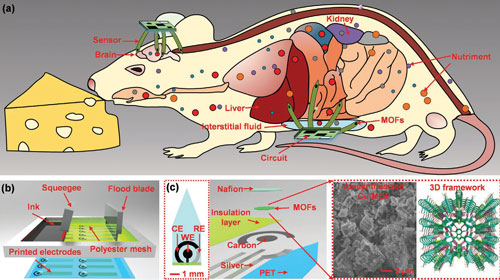| Posted: Jun 13, 2018 | |
Flexible, implantable nutrient sensors based on metal-organic frameworks |
|
| (Nanowerk Spotlight) One area where flexible and ultrathin electronics will lead to dramatic changes is the entire field of biomedical monitoring. In the not-too-distant future we could see implantable sensors that are self-powered and capable of continuously monitoring the function of organs and the level of analytes in different body fluids. | |
| Researchers in China now have demonstrated materials and techniques to achieve highly sensitive flexible biosensors integrated with metal-organic frameworks (MOFs) – essentially inorganic–organic hybrids that contain repeated metal ions connected with organic ligands. These high-throughput flexible devices can achieve highly specific and sensitive electrochemical detection and can be used to monitor neurotransmitters and nutrients in vivo. | |
| The team, led by Professor Xian Huang, Laboratory of Biological Flexible Electronics and High-throughput Measurement Technology Biomedical Engineering, Tianjin University, has reported their findings in Advanced Materials ("Materials and Techniques for Implantable Nutrient Sensing Using Flexible Sensors Integrated with Metal–Organic Frameworks"). | |
| "This is the first time that MOFs have been integrated with flexible electronic devices," Huang tells Nanowerk. "This integration enables new capabilities of flexible electronic devices in electrochemical detection of nutrients without using enzymes." | |
 |
|
| Schematics of MOF-modified flexible electrochemical sensors. a) The concept of the flexible MOF-modified sensors for nutriment sensing. b) The screen-printing process of flexible sensors. c) Multilayer structure of the MOFs electrochemical sensor, in which a MOFs layer is integrated. A scanning electron microscope (SEM) micrograph of Cu-MOF before grinding is shown in left, and a 3D framework structure of Cu-MOF through hydrogen bonds is shown in right. d) CV tests of bare electrode and Cu-MOF-modified electrode in PBS. (Reprinted with permission by Wiley-VCH Verlag) (click on image to enlarge) | |
| The capabilities of MOFs in catalysis have been extensively studied already. So far, though, there have been no reports in the literature discussing the application of MOFs in flexible electronics. | |
| This inspired the team to explore the possibility of integrating MOFs into their recently developed high-throughput flexible electrochemical sensors. | |
| "Despite various demonstrations of MOFs in chemical sensing, they have never been demonstrated in implantable biological sensing and integrated with flexible sensors to conduct multichannel determination of nutriments," says Huang. | |
| There are two important findings that result from the team's work. Firstly, it demonstrates that MOFs, which are intrinsically brittle and rigid materials, can be integrated with flexible electronic devices to achieve highly specific electrochemical detection with high resolution. | |
| Secondly, the results further demonstrate that flexible electronic devices can be used to monitor physiological signals inside the body in a distributed manner. | |
| The researchers fabricated their flexible sensors through a screen printing approach. The devices are surface modified by thin-films made of grinded copper-MOF (Cu-MOF) and cobalt-MOF (Co-MOF) nanoparticles. | |
 |
|
| Left: SEM micrographs of Cu-MOF nanoparticles on the surface of an electrode. Right: SEM micrograph of Cu-MOF-modified sensor in a sectional view. (Reprinted with permission by Wiley-VCH Verlag) | |
| These sensors can be used to detect trace amounts of ascorbic acid, L-Tryptophan, glycine, and glucose, all of which are nutriments that are closely involved in the metabolism and circulation processes. | |
| The team demonstrated that their sensors can operate under reduced bias voltage with prolonged working time for 20 days. They also presented preliminary data obtained by using bio-inspired tentacle-like multichannel sensors, indicating the potential applications of such sensors in simultaneous determination of distribution and transportation of analytes in different organs and body locations. | |
| As MOFs are very stable after implantation, the new technique could potentially be used to conduct long-term monitoring of biomolecules at different locations simultaneously. | |
| "We plan to combine optical and electrical stimulation, electrochemical detection, and other physiological signal monitoring to build high-throughput, distributed flexible electronics devices as tools to reveal complex mechanisms behind diseases and biological processes," Huang notes. "In addition, we also will further explore the applications of MOFs in flexible electronics by utilizing their advantages in long lasting phosphorescence, energy storage, and so on." | |
| "These devices could be used as a tool to help better understand various life processes," he adds. "They can be used as implants to monitor biomolecules at different locations of various organs. When integrated with more stimulation and measurement functions, this type of devices can be used to control animal behaviors, reveal underlying mechanism of biological processes, monitor health conditions, and treat diseases." | |
| Going forward, the team plans to introduce other rigid and brittle materials into flexible electronic devices to enhance the capability of flexible electronics. The challenges include how to achieve high performance flexible membranes using rigid and brittle materials and how to realize more implantable complex flexible electronic systems with comprehensive functions. | |
 By
Michael
Berger
– Michael is author of three books by the Royal Society of Chemistry:
Nano-Society: Pushing the Boundaries of Technology,
Nanotechnology: The Future is Tiny, and
Nanoengineering: The Skills and Tools Making Technology Invisible
Copyright ©
Nanowerk LLC
By
Michael
Berger
– Michael is author of three books by the Royal Society of Chemistry:
Nano-Society: Pushing the Boundaries of Technology,
Nanotechnology: The Future is Tiny, and
Nanoengineering: The Skills and Tools Making Technology Invisible
Copyright ©
Nanowerk LLC
|
|
|
Become a Spotlight guest author! Join our large and growing group of guest contributors. Have you just published a scientific paper or have other exciting developments to share with the nanotechnology community? Here is how to publish on nanowerk.com. |
|
